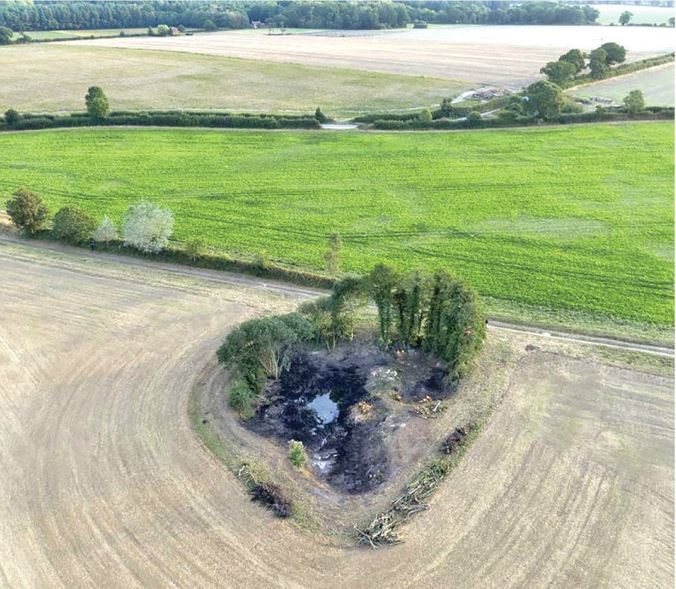Bringing buried wetlands back to life

By Matthew Brown & James Brooks
The ghosts are all around the gently rolling farmlands of eastern England. But you have to know where to look.
These are not the kind of phantoms that scare or haunt — they are ghost ponds. Over the years, landowners buried them, filling in wetlands so they had more land for planting crops and other needs, or let ponds fade away with neglect. Along with those ponds, they erased entire ecosystems — and contributed to the decline of wetlands worldwide.
The result: an array of environmental calamities, ranging from rising floods to species hurdling toward extinction.
There are some who are trying to reclaim these lost waterbodies. In the wetlands of eastern England, a motley team of farmers, university researchers and conservationists is digging into the region’s barley and wheat fields to turn back the clock. They seek out patches of muddy earth that hint at lost ponds lurking beneath.
Using chain saws, an excavator and plenty of sweat, the team takes just a few hours to resurrect one dying pond near Hindolveston, a thousand-year-old village not far from the North Sea. They fell trees and shrubs, then start digging until reaching their goal: an ancient pond bottom that once supported insects, aquatic plants and the birds and animals that fed on them.
“As soon as they get water and light, they just spring to life,” says Nick Anema, a farmer in nearby Dereham who has restored seven ponds on his property. “You’ve got frogs and toads and newts, all the insects like mayflies, dragonflies, damselflies. ... You can’t really beat a pond.”
But the battle for the wetlands is a struggle. While efforts are underway to stem losses and regain some of what’s been lost, wetlands around the world continue to be filled in and plowed over.
Almost 90% of the world’s wetlands disappeared over the past three centuries, according to the Ramsar Convention, an organization formed around a 1971 treaty to protect wetlands. The loss rate has accelerated since the 1970s, with wetlands now disappearing three times faster than the world’s forests, the group says.
Every type of naturally occurring wetland has suffered — from ponds, freshwater swamps and coastal marshes, to fens, bogs and other peatlands.
Climate change also threatens to worsen the problem. Warmer temperatures and changing rainfall patterns can trigger drought, leading to more pumping of water reserves that otherwise would feed surface wetlands, scientists say.
Wetlands in northern China, the central U.S., northern Africa, India and the Middle East already have been depleted by the pumping of underground aquifers for agriculture.
“We now know the value of wetlands, and we know with increasing precision how many wetlands we’re losing. The next step is for the governments to act,” says Royal Gardner, director of the Institute for Biodiversity Law and Policy at Stetson University in Florida.
A few hours of heavy rain in North Dakota are all it takes to transform the dry, cracked earth of the U.S. prairie into thousands upon thousands of pocket-sized wetlands.
The rain pools in shallow depressions known as prairie potholes and quickly flushes out insects from beneath the soil.
Each pothole becomes a haven for a pair of ducks. Two blue-winged teals dabble in one pothole that’s sprung back to life with the rains. Nearby, a mallard hen keeps her head down to the water, stuffing herself with insects and vegetation to store up the energy she’ll need raise her next brood, while a male, or drake, watches vigilantly for any predators. On the next pothole, two more ducks, then two more and so on, all the way to the horizon.
Recent News

Do not make expressions casting dout on election: EC
14 Apr, 2022
CM Bhatta says may New Year 2079 BS inspire positive thinking
14 Apr, 2022
Three new cases, 44 recoveries in 24 hours
14 Apr, 2022
689 climbers of 84 teams so far acquire permits for climbing various peaks this spring season
14 Apr, 2022
How the rising cost of living crisis is impacting Nepal
14 Apr, 2022
US military confirms an interstellar meteor collided with Earth
14 Apr, 2022
Valneva Covid vaccine approved for use in UK
14 Apr, 2022
Chair Prachanda highlights need of unity among Maoist, Communist forces
14 Apr, 2022
Ranbir Kapoor and Alia Bhatt: Bollywood toasts star couple on wedding
14 Apr, 2022
President Bhandari confers decorations (Photo Feature)
14 Apr, 2022











